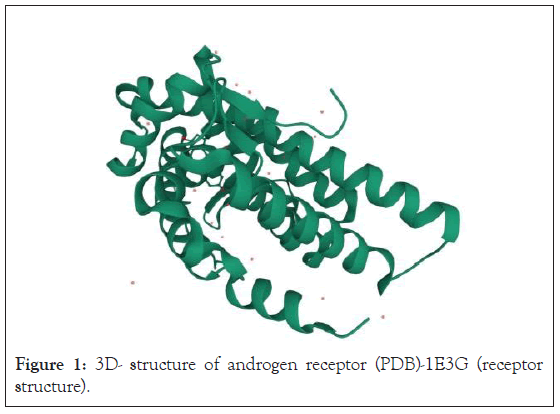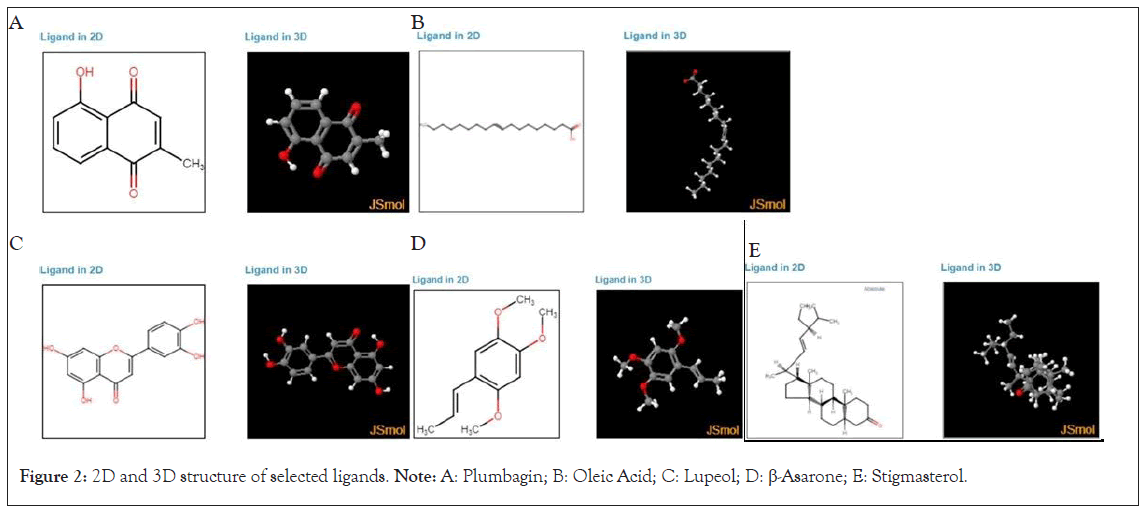
Journal of Clinical Trials
Open Access
ISSN: 2167-0870

ISSN: 2167-0870
Short Communication - (2024)Volume 14, Issue 5
Introduction: In Siddha medicine, a number of herbs are mentioned as possible cancer therapies, both alone and in combination. Such one of the best herb mention in siddha literature is VenKodiveli/ Ven chithramoolam. (PlumbagozeylanicaL.), which is an extremely powerful herb with wide distribution, and also component of many Siddha drugs Like Chitramoola kuligai, chithramoola thylam, etc. In that chithramoolakuligai is specially indicated for Yoni putru (Vaginal cancer), lingaputru (Penile cancer, Prostate cancer), Vippuruthi (All types of cancers). The objective of this study is performing in silico computational analyses of phyto constituents in extracts of the root of Plumbago zeylanica against antrogen receptor for prostate cancer.
Methodology: Docking calculations were carried out for retrieved phytocomponents of Plumbago zeylanica against the target Androgen receptor. Essential hydrogen atoms, Kollman united atom type charges, and solvation parameters were added with the aid of Auto Dock tools.
Observation and inference: Total of 5 bioactive lead compounds were retrieved from the herbal ingredients. From reported data of the herb, the phytochemicals such asLupeol and Stigmasterol reveals maximum of 5 interactions followed by which the compounds such as Plumbagin, Oleic Acid andβ-Asarone reveals maximum of 4 interactions with the core active amino acid residues present on the target androgen receptor.
Conclusion: Based on the results of the computational analysis it was concluded that the bio-active compound’s like Lupeol and Stigmasterol, Plumbagin, Oleic Acidandβ-Asaronepresent in the herbal ingredients possess significant binding affinity towards androgen receptor thereby it may greatly inhibits progression of prostate cancer. Further clinical trials would be beneficial in determining whether this herb is an effective therapy for prostate cancer.
Plumbagozeylanica L.; Prostate cancer
Cancer is a serious global health concern.It is estimated that 1.46 million cases of cancer occurred in India in 2022, and by 2025, that number is expected to climb to 1.57 million [1]. According to studies, prostate cancer is the fifth most prevalent disease overall and the second most common cancer in men diagnosed globally [2]. Elderly people are predominantly affected by prostate cancer. It ranks as the sixth most common cause of cancer-related deaths among men. Because of the advantages and significance of traditional medicine, the World Health Organisation has designated integrative oncology as one of the main goals of cancer therapy.
Objective
Binding of phyto components with the core amino acids (Leu 873, Gly 708, Arg 752, Met 745, Gln 711 and Met 749) of the target by forming hydrogen bond will hinder the function of the Human androgen receptorwith PDB(Name of the Target) –1E3G(Androgen receptor). The target androgen receptor highly involved in initiation and progression of prostate cancer by contributing to proliferation and differentiation of prostate epithelial cells during development of androgen dependent Prostate Cancer. Thereby phytocomponents which occupies the active amino acids on the androgen receptors will hinder its function and may act as a potential therapeutic agent for management of prostate cancer (Figure 1).

Figure 1: 3D- structure of androgen receptor (PDB)-1E3G (receptor structure).
Crystalline structure of the target enzyme Androgen receptor (PDB)-1E3G was retrieved from protein data bank and protein clean-up process was done and essential missing hydrogen atom were being added. Different orientation of the lead molecules with respect to the target protein was evaluated by Autodock program and the best dock pose was selected based on the interaction study analysis.
Docking calculations were carried out for retrieved phytocomponentsagainst the target Androgen receptor. Essential hydrogen atoms, Kollman united atom type charges, and solvation parameters were added with the aid of AutoDock tools [3-5]. Affinity (grid) maps of ×× Å grid points and 0.375 Å spacing were generated using the Autogrid program [3-5]. AutoDock parameter set- and distance-dependent dielectric functions were used in the calculation of the van der Waals and the electrostatic terms, respectively. Docking simulations were performed using the Lamarckian Genetic Algorithm (LGA) and the Solis and Wets local search method. Initial position, orientation, and torsions of the ligand molecules were set randomly. All rotatable torsions were released during docking. Each docking experiment was derived from 2 different runs that were set to terminate after a maximum of 250000 energy evaluations. The population size was set to 150. During the search, a translational step of 0.2 Å, and quaternion and torsion steps of 5 were applied (Figure 2, Tables 1-3).
| Compound | Molar weight g/mol | Molecular formula | H bond donor | H bond acceptor | Rotatable bonds |
|---|---|---|---|---|---|
| Plumbagin | 188.182 g/mol | C11H8O3 | 1 | 3 | 0 |
| Oleic Acid | 282.5 g/mol | C18H34O2 | 1 | 2 | 15 |
| β-Asarone | 208.25 g/mol | C12H16O3 | 0 | 3 | 4 |
| Lupeol | 426.7 g/mol | 1 | 1 | 1 | |
| C30H50O | |||||
| Stigmasterol | 412.7 g/mol | C29H48O | 1 | 1 | 5 |
Table 1: Ligand properties of the compounds selected for docking analysis.
| Compound | Est. free energy of binding | Est. inhibition constant, Ki | Electrostatic energy | Total intermolec. energy | Interact. surface |
|---|---|---|---|---|---|
| Plumbagin | -6.51 kcal/mol | 17.04 uM | -0.13 kcal/mol | -6.80 kcal/mol | 371.224 |
| Oleic Acid | -4.50 kcal/mol | 506.48 uM | -0.20 kcal/mol | -4.79 kcal/mol | 300.18 |
| β-Asarone | -5.22 kcal/mol | 149.17 uM | -0.09 kcal/mol | -6.45 kcal/mol | 465.787 |
| Lupeol | -2.51 kcal/mol | 14.52 mM | -0.06 kcal/mol | -4.78 kcal/mol | 665.339 |
| Stigmasterol | -3.25 kcal/mol | 4.12 mM | +0.02 kcal/mol | -5.46 kcal/mol | 654.167 |
Table 2: Summary of the molecular docking studies of compounds against androgen receptor (PDB)-1E3G.
| Compounds | Interactions | Amino acid residues | ||||||||||||||||
|---|---|---|---|---|---|---|---|---|---|---|---|---|---|---|---|---|---|---|
| Plumbagin | 4 | 704 | 707 | 711 | 745 | 746 | 749 | 752 | 764 | |||||||||
| LEU | LEU | GLN | MET | VAL | MET | ARG | PHE | |||||||||||
| Oleic Acid | 4 | 704 | 707 | 711 | 745 | 746 | 749 | 764 | 787 | 873 | ||||||||
| LEU | LEU | GLN | MET | VAL | MET | PHE | MET | LEU | ||||||||||
| β-Asarone | 4 | 704 | 705 | 707 | 711 | 745 | 746 | 749 | 764 | 787 | 873 | |||||||
| LEU | ASN | LEU | GLN | MET | VAL | MET | PHE | MET | LEU | |||||||||
| Lupeol | 5 | 704 | 705 | 707 | 711 | 742 | 745 | 749 | 752 | 764 | 780 | 873 | 876 | 877 | 880 | 891 | 895 | |
| LEU | ASN | LEU | GLN | MET | MET | MET | ARG | PHE | MET | LEU | PHE | THR | LEU | PHE | MET | |||
| Stigmasterol | 5 | 701 | 704 | 705 | 707 | 711 | 742 | 745 | 746 | 749 | 752 | 764 | 780 | 873 | 876 | 877 | 880 | 891 |
| LEU | LEU | ASN | LEU | GLN | MET | MET | VAL | MET | ARG | PHE | MET | LEU | PHE | THR | LEU | PHE | ||
Table 3: Amino acid residue interaction of lead against androgen receptor (PDB)-1E3G.

Figure 2: 2D and 3D structure of selected ligands. Note: A: Plumbagin; B: Oleic Acid; C: Lupeol; D: β-Asarone; E: Stigmasterol.
Total of 5 bioactive lead compounds were retrieved from the herbal ingredients. From reported data of the herb, the phytochemicals such asLupeol and Stigmasterolreveals maximum of 5 interactions followed by which the compounds such as Plumbagin, Oleic Acid andβ-Asarone reveals maximum of 4 interactionswith the core active amino acid residues present on the target androgen receptor.
Based on the results of the computational analysis it was concluded that the bio-active compound’s present in Plumbago zeylanica L. like Lupeol and Stigmasterol, Plumbagin, Oleic Acidandβ- Asaronepossess significant binding affinity towards androgen receptor thereby it may greatly inhibits progression of prostate cancer by limiting the proliferation and differentiation of prostate epithelial cells during development of prostate Cancer. Thereby phytocomponents which occupies the active amino acids on the androgen receptors will hinder its function and may act as a potential therapeutic agent for management of prostate cancer.
No funding.
No competing interests.
[Crossref] [Google Scholar] [PubMed]
[Crossref] [Google Scholar] [PubMed]
Citation: Lakshmi SS, Aishwarya A, Monika T, Kumari HVM, Kantham TL, Meenakumari R (2024) In Silico Molecular Docking Studies of Plumbago zeylanica L. against Androgen Receptor in Prostate Cancer. J Clin Trials. 14:569.
Received: 08-Jul-2024, Manuscript No. JCTR-24-31929; Editor assigned: 10-Jul-2024, Pre QC No. JCTR-24-31929(PQ); Reviewed: 24-Jul-2024, QC No. JCTR-24-31929; Revised: 31-Jul-2024, Manuscript No. JCTR-24-31929(R); Published: 07-Aug-2024 , DOI: 10.35248/2167-0870.24.14.569
Copyright: © 2024 Lakshmi SS, et al. This is an open-access article distributed under the terms of the Creative Commons Attribution License, which permits unrestricted use, distribution, and reproduction in any medium, provided the original author and source are credited.